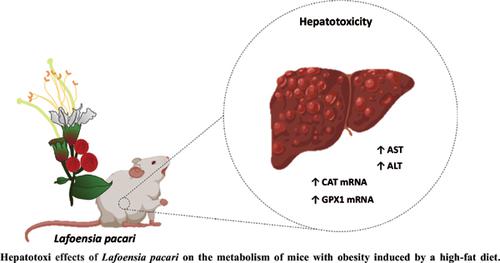Protein & Peptide Letters ( IF 1.6 ) Pub Date : 2021-06-30 , DOI: 10.2174/0929866528666210127151803 Natália Gonçalves Ribeiro 1 , Fabio Ribeiro Dos Santos 2 , Janaína Ribeiro Oliveira 1 , Amanda Souto Machado 1 , Deborah de Faria Lelis 1 , Alfredo Maurício Batista de Paula 1 , André Luis Sena Guimaráes 1 , Lucyana Conceiçáo Farias 1 , Sérgio Henrique Sousa Santos 1

|
Background: Brazilian flora is rich in plants with medicinal properties, which though popular, has contributed to the development of a range of phytotherapic products that use plants to treat and cure diseases. However, studies that use Brazilian plants in the treatment of metabolic disorders are still scarce in the literature.
Objective: The aim of this study was to analyze the effect of hepatotoxicity Lafoensia pacari on the metabolism of mice with obesity induced by a high-fat diet and to verify the phytochemical difference between the Lafoensia pacari bark of the trunk, leaves, and branches.
Methods: The plant material was collected from April to May in the municipality of Bonito de Minas, MG, Brazil. Qualitative tests for the presence of secondary metabolite classes were performed for leaves, branches and bark of the trunk. Through histological analysis, we evaluated hepatocytes and cell lesions in the liver.
Results: The comparative phytochemical analysis of the plant did not reveal alterations between the different plant parts. The phytochemical test showed that is preferable to use the leaves to make the extract to be applied, aiming to reduce the plant aggression. After treatment, greater changes were observed in the animals that received the high-fat diet and the hydroethanolic extract; the levels of AST, ALT, albumin and creatinine that were increased, thus demonstrating a possible toxicity. There were no significant differences in body weight. In the histological analysis, the animals without plant treatment displayed decreased liver weight and reduction in the inflammatory infiltrate.
Conclusion: We conclude that Lafoensia pacari should be better evaluated for oral consumption and may cause liver damage.
中文翻译:

Lafoensia pacari A. St. Hil 的肝毒性作用。(Lythraceae)在饮食诱导的肥胖小鼠模型上
背景:巴西植物群中富含具有药用特性的植物,这些植物虽然很受欢迎,但促进了一系列使用植物治疗和治愈疾病的植物疗法产品的开发。然而,使用巴西植物治疗代谢紊乱的研究在文献中仍然很少见。
【摘要】:目的:分析具有肝毒性的紫檀对高脂饮食致肥胖小鼠代谢的影响,验证紫檀树干、叶、枝的植物化学差异。
方法:植物材料于 4 月至 5 月在巴西 MG Bonito de Minas 市收集。对树干的叶子、树枝和树皮进行了次生代谢物类别存在的定性测试。通过组织学分析,我们评估了肝脏中的肝细胞和细胞病变。
结果:植物的比较植物化学分析没有揭示不同植物部分之间的改变。植物化学测试表明,最好使用叶子制成提取物,以减少植物的攻击性。治疗后,在接受高脂肪饮食和水乙醇提取物的动物中观察到更大的变化;AST、ALT、白蛋白和肌酐水平升高,从而证明可能存在毒性。体重没有显着差异。在组织学分析中,未经植物处理的动物肝脏重量减少,炎症浸润减少。
结论:我们得出结论,应更好地评估 Lafoensia pacari 的口服消费情况,并可能导致肝损伤。



























 京公网安备 11010802027423号
京公网安备 11010802027423号